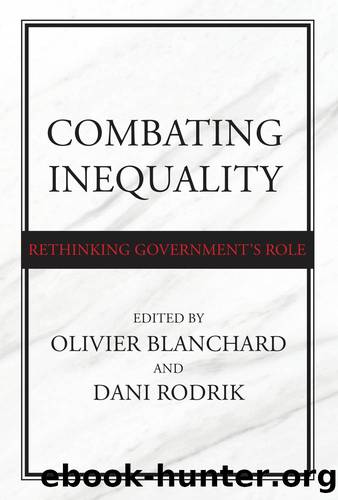Combating Inequality by Olivier Blanchard

Author:Olivier Blanchard
Language: eng
Format: epub
Tags: economic inequality; inequality; economic stratification; redistribution of wealth; wealth redistribution; progressive taxation; social safety net; political economy; minimum wage; labor market policy; human capital; trade; technological change; Olivier Blanchard; Dani Rodrik; Lucas Chancel; Peter Diamond; Danielle Allen; Philippe Van Parijs; Tim Scanlon; Ben Ansell; Sheri Berman; Nolan McCarty; Lawrence Katz; Jesse Rothstein; Tharman Shanmugaratnam; David Autor; Christian Dustmann; Caroline Freund; Greg Mankiw; Lawrence Summers; Emmanuel Saez; Daron Acemoglu; Philippe Aghion; Laura Tyson; Marianne Bertrand; Richard Freeman; William Darity Jr; David Ellwood; Heidi Shierholz; Jason Furman; Hilary Hoynes; Wojciech Kopczuk; Stefanie Stantcheva; Gabriel Zucman
Publisher: MIT Press
The most effective model for business and workers couples simple business and labor regulations with worker protections, such as in Denmark. Denmark ranks fourth on the World Bankâs Ease of Doing Business list (World Bank 2019b). The regulatory environment is designed to promote an efficient private sector, encouraging business formation and the expansion of productive firms, and forcing unproductive firms to exit. Worker protections, the most generous in the OECD, provide people with stable incomes and adequate opportunities.
In contrast, in the United States, the one credible jobs programâTrade Adjustment Assistance (TAA)âhas been too small to have a major impact. New research shows that TAA can be effective and have long-term positive consequences for workers who receive training (Hyman 2018), but providing assistance only to workers who lose jobs because of trade competition and offshoring is cumbersome to administer, resulting in few workers actually receiving support. Assigning a cause for job loss is not straightforward, as technology, trade, and demand are interlinked. Moreover, in small towns, the employment effects of manufacturing plant closures spread well beyond the firmsâ walls. In 2010, two million manufacturing workers lost their jobs in the aftermath of the financial crisis, but only 280,000 workers were certified for TAA and only 90,000 received training.
Moreover, TAA is the wrong way to help workers. As long as workers lose their job through no fault of their own, all workers should receive the same kind of assistance. Textile and furniture workers who have lost their jobs because of cheaper imports are not alone. Travel agents, coal miners, and retail workers have all experienced extensive job losses because of changing technologies or demand shifts. Labor-adjustment policies are essential for all these workers. Finally, focusing on TAA perpetuates the narrative that trade and offshoring are largely responsible for job loss.
Economists have typically preferred to focus spending on people rather than places, but there are examples of place-based policies working, especially during downturns. In Japan, worker support from active labor market policies is limited (figure 13.6). Instead, Japan has relied more on place-based policies, supporting areas where dislocations happen. Local authorities are charged with designing a job creation plan and then compete for supportive government subsidies. Evidence suggests that the program increases employment, especially in the agricultural, retail trade, and services sectors (Kazekami 2017).
In the United States, the relatively successful $80 billion auto bailout functioned like a place-based policy because the industry was agglomerated in towns in the Midwest. For example, Elkhart, Indiana, which produces one of every two recreational vehicles in the United States and where unemployment reached 20% in 2009, benefited significantly from the auto bailout. Its unemployment rate has been relatively low and fallingânow hovering below 3%.
To conclude, the trade shock at the turn of the millennium was exceptional. There were confounding factors in the United States and United Kingdom that exacerbated the effect on workers. In particular, their large and growing trade deficits, expanding financial sectors, weak secondary education, and the absence of robust labor adjustment (or place-based) policies left many workers behind.
Download
This site does not store any files on its server. We only index and link to content provided by other sites. Please contact the content providers to delete copyright contents if any and email us, we'll remove relevant links or contents immediately.
Bullshit Jobs by David Graeber(3958)
Radical Candor by Kim Scott(2595)
I Am Right, You Are Wrong by Edward De Bono(2348)
23:27 by H. L. Roberts(2155)
Nomadland by Jessica Bruder(1976)
Average Is Over by Tyler Cowen(1763)
The Conflict Resolution Phrase Book by Barbara Mitchell & Cornelia Gamlem(1685)
Out of Our Minds: Learning to Be Creative by Ken Robinson(1635)
High-Impact Interview Questions by Victoria A. Hoevemeyer(1620)
The Ideal Team Player by Patrick M. Lencioni(1573)
An Everyone Culture: Becoming a Deliberately Developmental Organization by Robert Kegan & Lisa Laskow Lahey(1536)
The Asshole Survival Guide by Robert I. Sutton(1515)
Automatic Society by Bernard Stiegler(1475)
Who by Street Randy & Smart Geoff(1431)
Unleashed by Anne Morriss & Frances Frei(1430)
Who Moved My Cheese?: An Amazing Way to Deal With Change in Your Work and in Your Life by Johnson Spencer(1423)
42 Rules of Employee Engagement by Susan Stamm(1406)
96 Great Interview Questions to Ask Before You Hire by Paul Falcone(1363)
The Power of Disability by Al Etmanski(1298)
